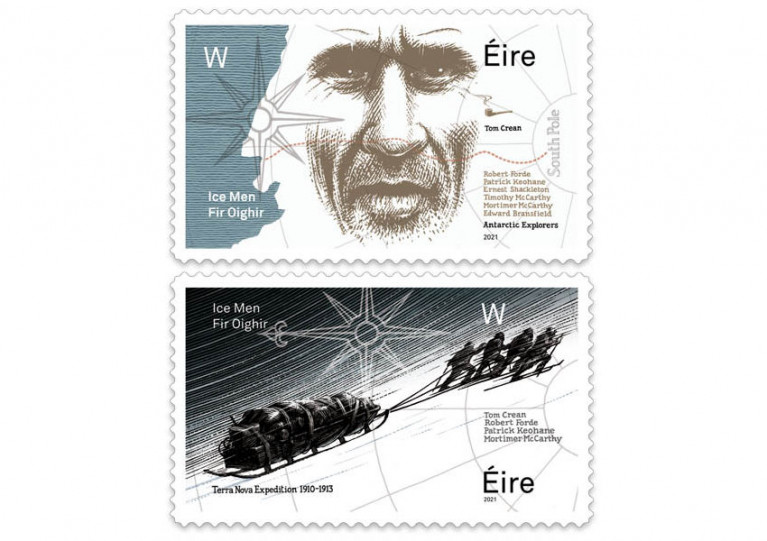Displaying items by tag: Tom Crean
The latest Library Blog post from the Royal Irish Academy celebrates the heroics and legacy of Irish polar explorer Tom Crean.
Collecting a number of revealing images — including a drawing of Crean’s Co Kerry home from the RIA’s own collection — the post traces the adventurer’s exploits with Captain Scott, first on the Discovery and later on the ill-fated Terra Nova, via the periodicals of the time.
Crean’s exploits have been widely recognised, most recently in a stamp set last year celebrating Irish men who played a significant role in the Antarctic expeditions of more than a century ago — and in the name of Ireland’s latest marine research vessel.
The RIA website has much more on Crean’s remarkable story HERE.
Tom Crean Features In New Stamp Set Celebrating Ireland’s Role in Epic Antarctic Expeditions
An Post has issued a new set of four stamps celebrating eight Irish men who played a significant role in the epic Antarctic expeditions of the 1800s and early 1900s.
Irish men were at the heart of the pioneering expeditions to Antarctica. Co Kildare-born Ernest Shackleton and Tom Crean, from Annascaul in Co Kerry, are two of the better known explorers, and have achieved worldwide recognition for their bravery and perseverance.
The other six men featured on the stamps, five from Cork, are less well known but no less important in the contributions they made to Antarctic exploration.
They include Edward Bransfield (from Ballincurra); Patrick Keohane (Courtmacsherry); Robert Forde (Bandon), brothers Mortimer and Tim McCarthy (Kinsale) and Francis Crozier (Banbridge, Co Down).
Leading Irish illustrator David Rooney explained how he wanted the stamps to shine a light on the impact Irish men had on Antarctic exploration.
“Like most people I was aware of the Shackleton and Crean expeditions, it was fascinating to delve into the adventures of a figure like Francis Crozier, who set out in 1839 as commander of HMS Terror on the Ross expedition,” he said.
“Crozier, his ship and all of his crew were subsequently lost, along with Sir John Franklin, on their ill-fated search for the North West Passage in the Arctic just a few years later.”
The four stamps, two for national postage and two for international, and a First Day Cover envelope are available at selected post offices and anpost.com/shop.
Shackleton's Cabin Restored In Connemara As Irish Woman Retraces Adventurer's Route
#Shackleton - As Shackleton's cabin arrives in Connemara for restoration, an intrepid young Irish woman is setting out to retrace the pioneering explorer's Antarctic footsteps.
According to The Irish Times, the 'sea bedroom' where Ernest Shackleton died of a heart attack in 1922 has been relocated to Conservation Letterfrack by its Norwegian owner for an array of restoration works before its transfer to the Athy Heritage-Centre Museum, in the explorer's county of birth, in the new year.
Originally part of the Norwegian steamship Quest, purchased by Shackleton for his final Antarctic voyage, the cabin was removed from the vessel at some point before the ship sank during a seal hunt in 1962, and wound up at a farm in Norway’s Nordland region, where present owner Ulfe Bakke played in it in his childhood.
Bakke has now donated the cabin to join a permanent exhibition in tribute to Shackleton's endeavours, including an original ice sledge and writings from his missions.
As previously reported on Afloat.ie, Shackleton's final resting place on South Georgia Island can be visited virtually via Google Street View.
Meanwhile, Irish Army Lieutenant Sinéad Hunt is entering her last fortnight of training before she embarks on a two-week trek across the Antarctic to mark the centenary of Shackleton's 1915 expedition, as TheJournal.ie reports.
The Dubliner will join New Zealand adventurers Tom McTavish and James Blake on the trip that will take them from the Falklands to South Georgia, following the arduous journey made by Shackleton, Tom Crean and four others after they abandoned the Endurance in pack ice.
To prepare for the challenge, the experienced climber and Alpine skier has been training in the Wicklow Mountains – but the severe storms and blizzards at the end of the world might prove a different prospect.
Shackleton's Island Resting Place Now On Google Street View
#Shackleton - When famed Irish explorers Ernest Shackleton and Tom Crean set foot on the island of South Georgia in 1916, it was as remote as one could get in the world at that time.
Fast forward to 2014 and the vistas of that Southern Ocean outcrop are available to all, thanks to an intrepid hiker equipped with Google's Trekker backpack camera.
As TheJournal.ie reports, Linbald Expeditions and National Geographic sent one of their videographers with the special 360-degree camera unit to capture images for the Google Street View virtual mapping service.
And the fruits of that adventure are some 10,000 shots taken across nine locations, roughly plotting the path that Shackleton and his crew took on their pioneering Endurance voyage - and their epic journey to seek rescue when the ship was trapped in ice.
Crean and four others joined Shackleton to set out across 1,300km of open ocean from Elephant Island on the edge of the Antarctic to South Georgia, where they were the first known to traverse its hostile landscape to reach the help they needed.
Even today that land is rarely visited, with a population of just 30 or so - mostly scientists and staff of the British Antarctic Survey.
But now anyone in the world can have a glimpse of its rugged natural beauty, from the penguins of Right Whale Bay to Shackleton's final resting place.
TheJournal.ie has much more on the story HERE.





























































